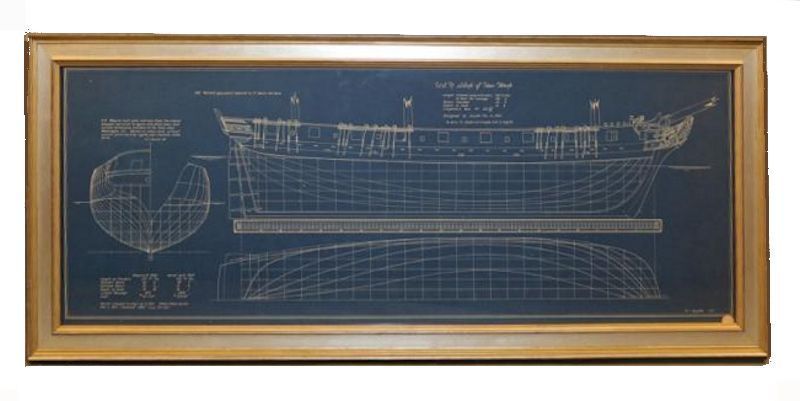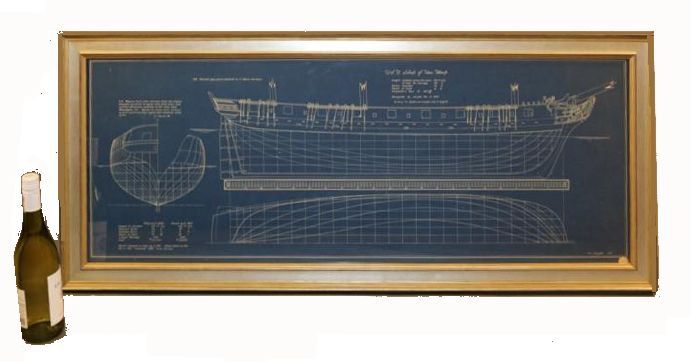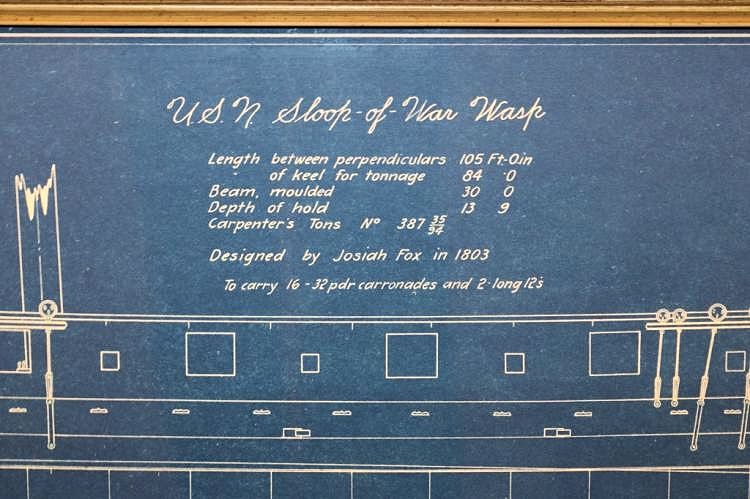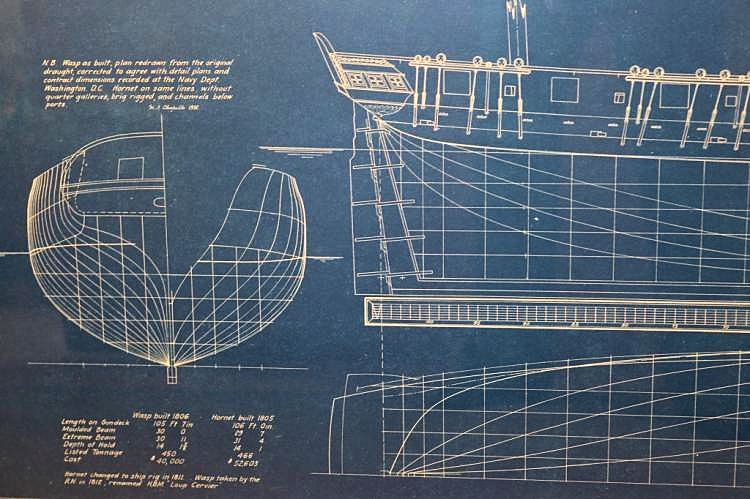FRAMED BLUEPRINT OF USS SLOOP OF WAR “WASP” Ca
1806

20th Century
Viewing area 22 3/4″ x 34 3/4″ Framed 20″x 49″
Signed lower right
H. Chapelle, 1932

The
wine bottle is shown for size comparison only.Presented
is a framed blueprint of USN Sloop of War “Wasp” drawn by noted naval architect and historian, Howard
I. Chapelle 84 years ago in 1932. It shows the hull profile and full hull lines, including details below the waterline,
bow, etc. Signed lower right “H Chapelle.” She was the second
USS WASP of the United States Navy. Constructed in 1806 at the Washington Navy Yard and commissioned in 1807 under command
of Master Commandant John Smith. She was captured by the British in the early months of the War of 1812.
DETAILS of this USS WASP sloop
of war, 1807-1812:
Length on deck
105’7” (32.2 m).
Beam, mld 30’0”
Beam, max 30’11”
Displacement 460 tons
Complement 140 officers and enlisted
Armament 16
x 32 pndr. carronades plus 2 x 12 pndr. guns Service history: Wasp’s service
in 1807 and 1808 remains unrecorded. In 1809, she was cruising the eastern coast of the United States. By the end of 1810,
she was operating from the ports of Charleston, South Carolina, and Savannah, Georgia, presumably concentrating on the waters
along the southern portion of the country’s eastern coast. In 1811, she moved to Hampton Roads, Virginia, where she and
brigantine Nautilus, joined frigates United States and Congress in squadron commanded by Commodore Stephen Decatur. Wasp continued
to operate along the coast of the middle states after the United States went to war with Britain in June 1812. Her single
action of that war came in October 1812. On the 13th, she exited the mouth of the Delaware River and, two days later, encountered
a heavy gale which carried away her jib boom and washed two crewmen overboard. The following evening, Wasp came upon a squadron
of ships and, in spite of the fact that two of their number appeared to be large men-of-war, made for them straight away.
She finally caught the enemy convoy the following morning and discovered six merchantmen under the protection of HMS Frolic,
a standard 18-gun brig sloop of the Cruiser class. At half past eleven in the morning of 15 October, Wasp and Frolic closed
for battle, commencing fire at a distance of 50 to 60 yards. In a short, but sharp, fight, both ships sustained heavy damage
to masts and rigging, but Wasp prevailed over her adversary by boarding her. Unfortunately for the gallant little ship, a
British 74-gun ship of the line, HMS Poictiers appeared on the scene, and Wasp became a British prize. Wasp’s commanding
officer, Master Commandant Jacob Jones, had to surrender his small ship to the new adversary because he could neither run
nor hope to fight such an overwhelming opponent. Wasp was taken in the Royal Navy as HMS Loup Cervier. In 1813 she was again
renamed Peacock but was foundered in August 1814 off the southern coast of USA. The Wasp Islands, part of the San Juan Islands
of Washington state, were named after the USS Wasp.
 Significant
Significant
details of the USS Sloop of War USS Wasp CONDITION:
The frame is is in excellent condition and the paper dust cover on the back is fresh. The blueprint has not been
inspected outside the frame, but looks in perfect condition. There is a small sticker inside the glass at the lower right.
It looks to be old.
 Close up of the Transom, Stern sections of the Sloop of War Wasp
Close up of the Transom, Stern sections of the Sloop of War Wasp
BIOGRAPHY
of Howard I. Chapelle: Chapelle was born on February 1, 1901. From 1919, he worked as a marine apprentice and designer
for a number of shipbuilders. After 1936, he went into business for himself, and later served as head of the New England section
of the Historic American Merchant Marine Survey, a New Deal project designed to research American naval history and staffed
by unemployed marine architects. During
World War II, Chapelle served in the United States Army Transportation Corps ship and boat building program. In 1950, he ventured
to England where he researched colonial ship design on a Guggenheim fellowship. In 1956/57, he served the United Nations Food
and Agricultural Organization as a consultant on fishing boat construction to the government of Turkey. Upon returning to
America, he was appointed Division of Transportation curator of the National Museum of History and Technology. Ten years later,
in 1967, he stepped down as curator to assume the role of Senior Historian. He retired in 1971, accepting the title of Historian
Emeritus. Chapelle died
in Lewes, Delaware, on June 30, 1975. Noted
Works: Chapelle was
a small-boat enthusiast and sailor. He felt that inexpensive yachts based on traditional work boats were the most practical
way to go sailing and designed a number of small boats. His article on a 14-foot (4.3 m) Chesapeake sharpie skiff is typical
of many of his articles His book
American Small Sailing Craft (1951) W.W. Norton & Company is considered a classic among small-boat builders and historians.
In it he documented many fast-vanishing American working boats. Other classics are The History of American Sailing Ships and The History of the American Sailing Navy: American Small Sailing Craft (1951) all by W.
W. Norton & Company
Blueprint Sloop of War USS Wasp Ca 1806
Shipping & Packaging
The cost of shipping, packing, handling, and insurance to your destination, will be calculated point to point and is an additional charge. You may email us to get these costs. We price our shipping honestly, but we expect to be reimbursed for the nominal cost of packaging materials and handling.
Our Unconditional 'No Nonsense' Guarantee
If not completely satisfied with your purchase it may be returned, if without damage, within three days of receipt in its original packaging. Return items must be insured for their full value. Only a prior email authorization by us for the return is required. Shipping charges are refundable if due to our error within the continental United States.
International buyers welcome, but inquire first. We have satisfied customers worldwide.
Standard Forms of Payment
Bank wire transfer, cashier’s check, money order, or personal check in which case the item will be held until cleared. Our prices are quoted net to us so that the use of credit cards or PayPal incur extra charges. Terms on overseas sales are different.
